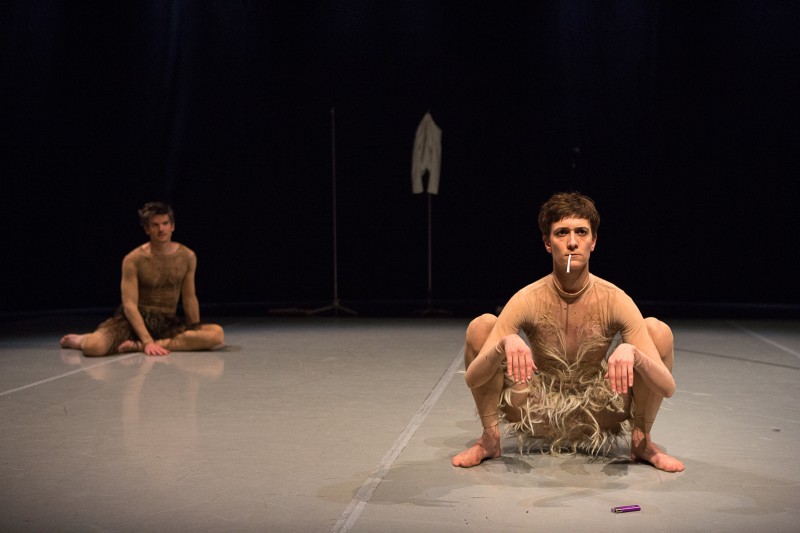 Lost Dog’s dance theatre went global in 2011 with their Place Prize-winning It Needs Horses, which has toured extensively since. Lucy Kirkwood’s Olivier award for Chimerica earlier this year has cemented her reputation as one of the foremost British playwrights of her generation. Like Rabbits, the world-premiering collaboration between them, holds the promise of combining Ben Duke’s emotionally immediate choreography with Kirkwood’s panache with ideas and is a red hot ticket. This combination of movement and new writing is a challenge many artists have grappled with, raising issues of hierarchies of meaning and the interaction between registers of communication – detail, abstraction, the play of interior worlds and exterior expression – but it’s hard to imagine two artists of the moment more suited to the task.
Lost Dog’s dance theatre went global in 2011 with their Place Prize-winning It Needs Horses, which has toured extensively since. Lucy Kirkwood’s Olivier award for Chimerica earlier this year has cemented her reputation as one of the foremost British playwrights of her generation. Like Rabbits, the world-premiering collaboration between them, holds the promise of combining Ben Duke’s emotionally immediate choreography with Kirkwood’s panache with ideas and is a red hot ticket. This combination of movement and new writing is a challenge many artists have grappled with, raising issues of hierarchies of meaning and the interaction between registers of communication – detail, abstraction, the play of interior worlds and exterior expression – but it’s hard to imagine two artists of the moment more suited to the task.
It’s a short, dense piece, adapting the Virginia Woolf short story Lappin and Lapinova about a couple who develop a fantasy relationship as a rabbit king and queen, escaping the strictures of Edwardian polite society. Eventually the practical demands of being a part of the world overcome the alternative reality of their relationship, with the husband dealing the final blow, leaving his young wife trembling at the stultifying prospects of their future.
Duke and Kirkwood have transposed the story to the present day – we open in a night club with an all too familiar scene of a young man nervously failing to chat up to the cooly smoking object of his desires. He dances his chat up and there are some great comic moments in these early scenes: by shifting the action to the more permissive contemporary world, the latent sexuality and role-play of the set up come to the fore. Holly Waddington and Susanna Peretz’s second skin rabbit costume designs are tactile and charged: putting them on does indeed make each character strange.
The use of language is spare and simple – anyone hoping for chapter and verse (by either Kirkwood or Woolf) will be disappointed – almost all the detail and lyricism is transposed into movement. This makes for a highly compressed choreography: we observe the relationship through series of music-driven scenes, each a single carefully selected song from a highly eclectic score. So the music is as much part of the language of the whole as the movement, with only the occasional misstep in the play of meaning, in Ino Riga’s early solo to Mary & the Boy’s Fuck Me, where movement and song seem merely to be repeating one another. The dances are playful, sensuous and highly identifiable, the clear emotional and imagistic line of the story gives us plenty of points of entry to read on stage, though the density of the interaction is sometimes too rich to fully digest at one sitting.
It is a thing of beauty to look at. The design plays with dualisms, black and white, light and shade, magnifying the gendered contrasts of the Edwardian world of the original story. The bare white stage and two simple stools recall the circus ring of It Needs Horses, placing this work in conversation with the last. Designer Jackie Shemesh’s lighting design creates stunning stage images – pools of light that separate and touch; dancing shadows that multiply the bodies, their couplings and their conflicts on stage.
Words, when spoken, are effective. They express ideas – such as the glorious banality of a perfectly selected shopping list as a metaphor for the oppressive ordinariness seeping into the relationship – that could not be communicated physically (though in this case, the same core idea is later reiterated very effectively in the closing image). There’s a real sense of the working of the material to identify in each moment the most effective form for its expression and it’s great to see such literary material effectively translated into physical form.
However, by re-contextualising the story, some of its shape is flattened out: in replacing the social pressures affecting the story’s female protagonist, voiceless in a masculine society, with the emotional pressures of maintaining intimacy, playfulness and sex in a modern long term relationship, the material loses some of its bite and feels a little more obvious. There’s less sense of progression, which means the shape can sometimes feel repetitive and the male character’s motivation more arbitrary in this version: why wouldn’t he be just as invested in retaining those qualities in his relationship? Despite this caveat, Like Rabbits is a rich and engaging production packed with interesting decisions about conveying experience through movement, images, music and words. It builds on the audience friendliness of It Needs Horses whilst offering highly appetising food for thought about the ongoing possibilities of dance theatre.

